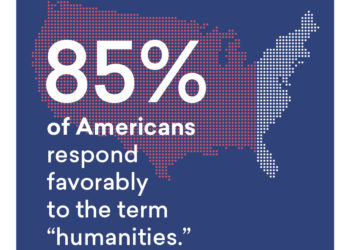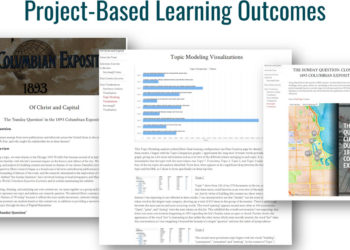It’s not all bad news for the humanities in the United States, but there isn’t much good news either. The Humanities Indicators Project released a new report today, “State of the Humanities 2022: from Graduate Education to the Workforce,” that offers some sobering perspective on what seems like a perennial and intensifying crisis. The material in the report comes from data collected by U.S. Department of Education and the National Science Foundation, and covers the period 1988-2020 with some focused attention on shorter periods for specific issues and questions.
“From Graduate Education to the Workforce” describes graduate education in the Humanities — Masters and Doctoral degrees — and its relationship to employment with a closer look at who has been earning those degrees, who is offering those degrees, how people assess the value of their degrees, and how those degrees are translating to paid employment and of what type. Robert Townsend, co-director of the Humanities Indicators, noted to me that the report offers “a lot for the field to ponder … as it thinks about the purpose of graduate education, and what they are doing for their students.”

New graduate degrees in the humanities have declined, and are at the lowest levels ever recorded as a share of total master’s and doctoral degrees (just 7% of total doctoral degrees in 2020). Despite these declines, as anyone with a recently earned humanities PhD knows, there is a five-alarm fire in higher education employment, even while those with advanced degrees in the humanities remain more dependent on academic employment than folks in other fields. The job market for the humanities in higher ed has been in a slump since 2008, and in precipitous decline in the last few years. Job ads placed at the major scholarly societies have been trending sharply down, but a better indicator might be that in 2020 only 47% of new PhDs in the humanities had a job lined up at graduation, compared to 63% in 1990. During that same period, the number committing to postdoctoral study (fellowships) grew from 4% to 12%. So, 67% of new PhDs had a combination of employment or a (presumably time-limited) postdoc confirmed at degree completion in 1990, compared to 59% in 2020. The report concludes with an understatement: “given the seven-year time to PhD, it is challenging for anyone entering a PhD program to anticipate [either] improvements or declines in the academic job market. We cannot put the trends on a balance sheet and calculate the risks and rewards.”
Perhaps most alarmingly, the lack of diversity in the humanities continues to intensify at every degree level; only 18% of recent doctoral degrees in the humanities were awarded to scholars from traditionally minoritized racial and ethnic backgrounds, but that is 4 full percentage points lower than all fields combined. The share of graduate degrees awarded to minoritized students has increased at both the Master’s and Doctoral level over the last two decades (from 11% to 20% at the Doctoral level) but this data may obscure that other, more revealing, finding. While the humanities was holding its own with other fields at over 44% of Associates degrees awarded to minoritized students from 2016-2020, there was a decline beginning with Bachelor’s degrees across all fields — but a steeper decline in the humanities.
So where’s the not terrible news? Among the few less terrible findings, humanities departments do not seem to have intensified their reliance on adjunct faculty, at least as recently as 2017. It seems logical to attach the decline in humanities higher education employment to adjunctification, but the data does not bear that out. Or at least data collected thus far cannot explain the decline as a correlation to increasing reliance on adjunct teaching. From 2007-2017, it looks like some specific fields had more tenure or tenure track faculty than others (more in History of Science and American Studies, than in English and Communication, for example). In 2017 more than 60% of faculty in all humanities disciplines were in tenured or track-track positions, about 20% were full-time non tenured or tenure track, and just over 20% were non tenured or tenure-track and part-time. (Other data for all fields and in specific schools and markets, can look quite different as this article from the Washington Post details.) A particularly interesting data point from 2019 will bear watching: among those humanists who were working in academia part-time, 44% reported doing so because full-time employment was not available, somewhat higher than for all fields. But a close percentage reported that they “did not need or want to work more.” And job satisfaction among graduate degree holders in the humanities is pretty high; as of 2019, despite lower median earnings, 90% of humanists reported they were “at least somewhat satisfied with their employment.”
The Humanities Indicators Project has looked at the humanities across educational sector and more recently also at public understanding of and appreciation for the humanities. This work is important as we see a drumbeat of bad news, that is, both actual bad news but also relentless coverage of the “Crisis of the Humanities.” Even a quick online search will send you to what Paul Reitman and Chad Wellmon have recently called a Permanent Crisis. Reviewing their book that historicizes the humanities and calls for a return to disciplinary thinking, historian Johann Neem described the author’s assessment thus: “the humanities can’t save the world; they are tools to help us understand that world.” For the New Yorker, philosopher Agnes Collard reflected on the pandemic, wondering what the humanities could offer. Maybe it’s a way of learning in crisis. To “halt the crisis in the humanities,” way back in late 2019 — so, pre-pandemic — scholars and professors of English Clifford Siskin and William Warner called for “de-zoning” knowledge. Reflecting, like Reitman and Wellmon on the history of the very concept of the “Humanities” in the evolution of disciplines and their acceleration with the rise of research universities, they wondered whether we should be more aggressively working across the (often false or at least rickety) those divides.
For sure, human comprehension is not divided into academic disciplines; we do not either experience or perceive our medical condition without a historical understanding of the politics of bodies, for example. Humanistic inquiry seems self-evidently valuable. And yet we live in a world in which humanities education, and humanities research, seems perennially at risk of extinction. No matter the long duree perspective of some downplaying crisis or seeing crisis as inherent to the humanities, in 2018 historian Benjamin Schmidt offered a different view. The perception that the humanities are a less significant preparation for careers – for life – seems pervasive among undergraduates and their parents despite employers continuing to call for the kind of skills that the humanities provide.
Right now, the biggest impediment to thinking about the future of the humanities is that, thanks to this entrenched narrative of decline — because we’ve been crying wolf for so long — we already think we know what’s going on. The usual suspects — student debt, postmodern relativism, vanishing jobs — are once again being trotted out. But the data suggest something far more interesting may be at work. The plunge seems not to reflect a sudden decline of interest in the humanities, or any sharp drop in the actual career prospects of humanities majors. Instead, in the wake of the 2008 financial crisis, students seem to have shifted their view of what they should be studying — in a largely misguided effort to enhance their chances on the job market. And something essential is being lost in the process. —
Benjamin Schmidt, “The Humanities are in Crisis,” The Atlantic
In other words, perception drives action here. Undergraduate students are “fleeing humanities and related fields specifically because they think they have poor job prospects.” According to a report from the MLA in 2019, colleges cut almost 700 language programs in three years – pre-pandemic; humanities undergraduate and graduate programs have been threatened and cut from public and private universities alike.
Though the Humanities Indicators report on graduate education is using pre-pandemic data, the situation since 2020 is likely worsening. A tight spiral of illogic around undergraduate perceptions and political calculations about field viability in the culture wars is making graduate education in the humanities harder to undertake; ultimately this will all make it harder to teach and to learn the humanities even while we live through an era where humanistic perspectives on climate, democracy, and technology are urgently necessary. In particular we need the perspectives of those students who drop out of humanities study — who find it unappealing, impractical, or unwelcoming — as they progress through advanced degrees.
So is a perception of the humanities and employment for undergraduate education driving an intensifying and dire reality of the humanities and employment for graduate students? Anecdotal commentary suggests that advanced humanities degrees are undesirable for employers outside of academia; it would be incredibly useful to have data to address this issue head-on. The differences in Masters and PhD employment sectors in this report is a start, but in both cases we still see education, either secondary education or higher education, as the primary employer for humanists. If we believe that humanistic methods and perspectives are useful across a range of endeavors — and the background that a humanistic education provides is equally essential — we ought to be able to demonstrate that advanced training provides an enhanced benefit for students and a wider range of employers as well as society at large.
Discussion
5 Thoughts on "Humanities and Graduate Education: The Crisis is Real, but Not New"
Crisis is so ably and timely brought out at a time when crisis round the world and nature requires humanities to be more inviting. An excellent piece giving us a glimpse of the crisis from the academic zone. The issue of culture wars could have been a bit extended as it leaves the author’s views slightly ambiguous.
Interesting. The same was said in 1969 when I graduated. I went into publishing and had a very rewarding career. My daughter went into banking and is enjoying a rewarding career. My sons are builders and counselors. Enjoying rewarding careers.
None were STEM majors.
I told my children go to college and study what you find interesting. It will probably have nothing to do with what you do to earn a living, but it will broaden your horizons and make your life more enjoyable.
“Among the few less terrible findings, humanities departments do not seem to have intensified their reliance on adjunct faculty, at least as recently as 2017. It seems logical to attach the decline in humanities higher education employment to adjunctification, but the data does not bear that out.”
The conundrum may be less puzzling once one understands how predominant the master’s degree is in the non-tenure-track academic workforce. I assume that by the phrase “humanities higher education employment” employment in a tenured or tenure-track faculty position is meant. Employment off the tenure track is “higher education employment” in a faculty position, so the logic of attributing a decline in such employment to reliance on adjunct faculty must mean that “humanities higher education employment” is short for “humanities higher education employment in a tenured or tenure-track position.”
The 2004 National Study of Postsecondary Faculty (NSOPF:04) documented the sharp divide in degree qualifications of humanities faculty members on and off the tenure-track. Yes, the NSOPF:04 data are now so old as to make them questionable as an indicator for current conditions; but they are the best, indeed the only, such data we have on this question. In four-year institutions NSOPF:04 found 95% of tenured and tenure-track faculty members in the humanities held the PhD, compared with 35% of their non-tenure-track colleagues. In two-year colleges, the percentage of humanities faculty members with tenure or on the tenure track who held the PhD was 32%—strikingly close to the 35% for non-tenure-track faculty members in four-year institutions. The NSOPF data strongly suggest that a master’s degree has been the accepted degree qualification for teaching in the first two years of college, whether those two years occur in a four-year or a two-year institution.
Old the NSOPF:04 data may be. But the source date of the NSOPF findings on degree attainment helps us see that, historically, the rise of a majority non-tenure-track academic workforce cannot have been driven primarily by the production, or over-production, of PhDs. As a corollary, a strategy of cutting the production of PhDs will do little to remediate the adjunct labor problem, given that, with a plenitude of PhD recipients to turn to, institutions have drawn from the labor pool of master’s degree holders to fill non-tenure-track positions. There are many good reasons to advocate PhD population control. The idea that reducing the supply of PhD talent will work to correct the adjunct labor problem is not one of them.
What is clear is that the question of the size of the PhD enterprise does turn directly on the question of humanistic career aspirations, possibilities—and outcomes. As data in the Graduate Education to Career report document, in the humanities more than in any other disciplinary area, doctorate recipients focus their ambitions on academia. And for both doctoral programs and their graduates, success has largely been defined, and confined, to the goal of a tenure-track professorial career. Resolution of the decades-long argument about the appropriate size and number of doctoral programs in the humanities may well come down to whether recent efforts to diversify graduate, and especially doctoral, student career aspirations and outcomes flourish or wither.
The logic of the relation between tenure-track and adjunct employment becomes clearer once one understands how to read the charts in the report that show the percentage of both Master’s and Doctorate recipients employed in faculty positions in higher education. Those charts tell us that about 60% of PhDs and about 15% of MAs were employed as postsecondary teachers in 2019. What needs to be remembered is that the base number for the 60% of PhDs lies somewhere between 5,000 and 6,000, while that for the 15% of MAs falls somewhere between 25,000 and 30,000. Those numerical quantities matter.
Thank you for this comment, David, and apologies for my slow reply! You are so right about that data– it’s significance and also the need for an update. I’d like to know what’s happened up to 2020 with community colleges and I’d also like to know what’s happened since 2020. Both seem vital. And agree absolutely that the career aspirations of the PhD are paramount.
“What needs to be remembered is that the base number for the 60% of PhDs lies somewhere between 5,000 and 6,000, while that for the 15% of MAs falls somewhere between 25,000 and 30,000. Those numerical quantities matter.”
I just realized that statement needs to be corrected, although the basic point holds, I think. The numerical bases for the 15% and 60% figures are all PhDs and MAs “employed within the last five years,” as estimated from the National Survey of College Graduates (the source for this information.) See notes 12, 13, and 14 on page 38 of the report. Between 5,000 and 6,000 *new* PhDs are added each year to the total population of humanities PhDs. Between 25,000 and 30,000 *new* MAs are added each year to the total population of terminal humanities MAs. The exact size of the two populations of course changes; each year people are subtracted as well as added. The point holds that the 15% of humanities MA holders employed as postsecondary teachers is 15% of a much, much larger population than that from which the 60% of PhD holders is drawn.



